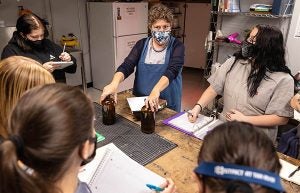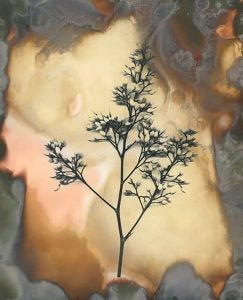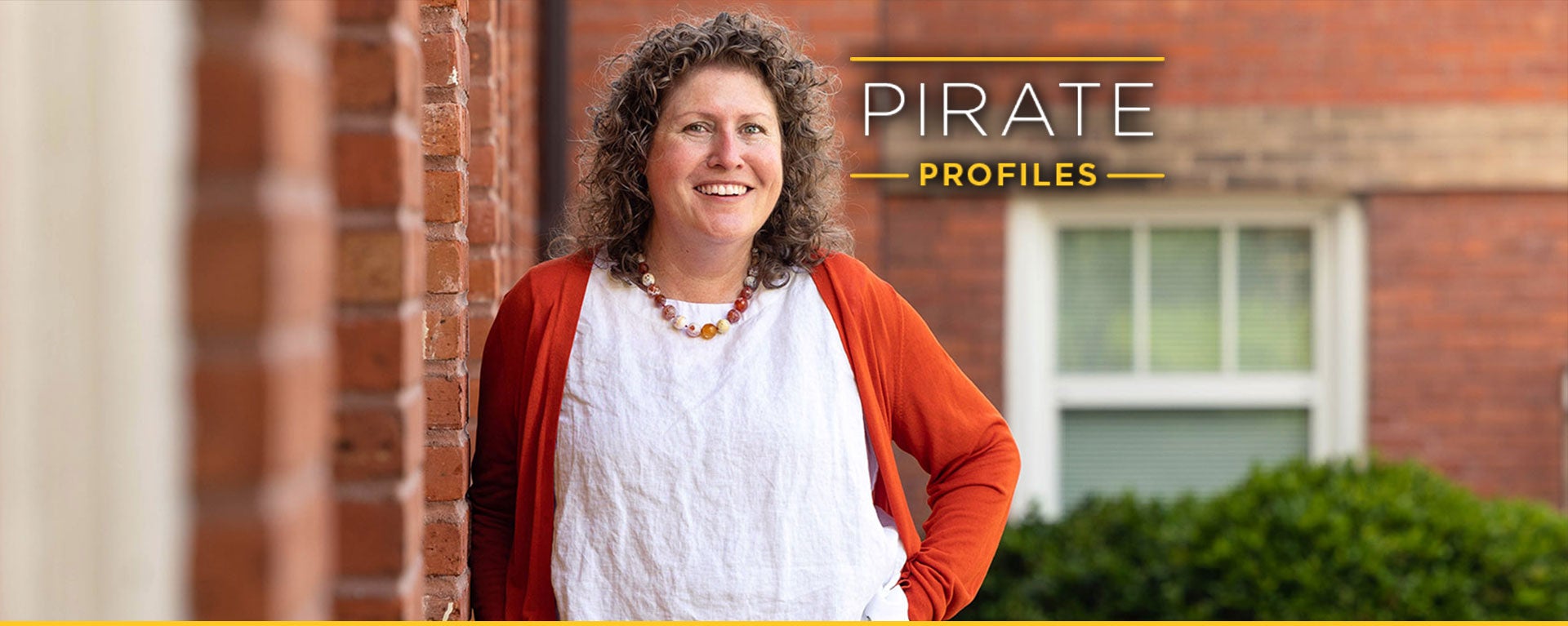Faculty: Angela Wells
Angela Wells has always been creative. All you have to do is ask the children who received one of the balloon animals she used to make when she worked in high school.
“It was a lot of fun,” said Wells, an associate professor in the East Carolina University School of Art and Design. “I was making balloon animals and figures. I went through some training and learned how to do some basics and then you figure out some stuff. You shared secrets with other twisters, and you also had to learn on the fly because you were essentially walking around in restaurants and you would get these kids who would ask for something you’ve never made before and you don’t want to disappoint, so you give it your best.”
Still, as it came time to decide on her major as she entered college, she gravitated toward something practical and decided to go into medicine.
“Sometimes we’re encouraged to do things that are recognizable and admirable professions that will help the community, so for me being a kid from maybe not the nicest part of town, that seemed like a way to get out and be helpful,” Wells said. “But I learned pretty quickly in college that my brain functions in a different way.”

Angela Wells teaches a class in a lab in the Jenkins Building.
A failing grade in a biology class provided her that lesson. The instructor provided her a direction toward her passion — and as it turned out — a career teaching photography and art.
“I had a heart-to-heart with my advisor who was my biology professor at the time, and he asked me if there were other things that I liked to do, and I said, ‘Well, I like art.’ He asked me if I was any good, and I said, ‘I used to be.’ He suggested I take a few classes, and I did,” Wells said. “I took photography and I took a basic art class as well, and I remembered how much I loved it. It made me feel — alive isn’t the right word — but I was excited about learning.”
She decided to major in both psychology and studio art, and after getting her degrees, had a new challenge in front of her.
“When I graduated from undergrad, I wasn’t sure, like most people, what I wanted to do with my life,” she said. “I had the two degrees and I liked parts of both of them. I had to get things figured out and I thought that teaching could be fun, so I joined Teach for America. I moved from L.A. to rural North Carolina as a two-year commitment, and I stayed three. I figured Teach for America would be a great way to give back for all those scholarships and grants that I got, and it would give me a chance to see if I actually liked teaching and some time for me to actually figure out what I wanted to do next, and to be a grown-up and take care of myself.”
She taught special education, but “I missed making photographs, so I started teaching driver’s ed so that I could afford to build a darkroom and keep making art,” she said. “I discovered that I loved teaching but I wanted to teach what I loved, so I decided to go back to grad school and work on getting my MFA (Master of Fine Arts) so I could teach.”

“Like a Tree” is an example of some of Wells’ work.
Wells learned about a job opening at ECU through an email from a stranger who graduated from the same master’s program as her.
“I looked into the program, and the faculty and everything were fantastic,” she said. “When I came to campus for my interview, it felt right. The people here are fantastic. I’ve been to other universities, and it was one of the first times I wasn’t nervous answering questions or talking about my work. It felt good, and everybody here really seemed to have a good experience and just loved teaching, and that was cool. They offered me the job, and I haven’t left because my initial experience has only been reinforced. I have incredible colleagues here, and on a national level there are a lot of things people who aren’t in North Carolina can say that we’re this little school or we don’t have a huge museum or gallery scene, but we have a lot of things for me that matter. I feel valued when I teach here, and the students who come here are pretty phenomenal.”
She teaches her students that photography is so much more than an image on Instagram.
“If there were fewer bad photographs on Instagram, if I have to look at fewer pictures of your food and bathroom selfies before you go out to the club, then I’ve done my job,” she said.
Wells enjoys what photography offers.
“I think it has more possibilities than a lot of other mediums,” she said. “You can use it to tell truths, to show events, to expand experiences of people, but then you can also use it as a complete tool of imagination and make up the world you want to live in, things that you want to see. There is no other medium that gives you that flexibility, and I like lots of options. … That’s why I like photography. There are so many possibilities, and I don’t think there’s a right or a wrong.”
Wells enjoys the process of making photographs.
“I really like learning new processes, new ways of making photographs, and the first one that works, the first one that is successful in any new process, is completely mind-blowing and invigorating,” she said. “I still remember the feeling of watching my first darkroom print come up, and I still have it.”
In an era when cell phone photographs offer instant gratification, Wells gets her students to slow down and enjoy the creative process that occurs in a darkroom.
“I think it’s kind of refreshing for a lot of people,” she said. “With things like Instagram, we process and consume images so fast, and you can’t do that in a darkroom. I have students who will spend an hour and a half processing a roll of film, and they don’t know what the pictures look like. They have to wait for them to dry and then make a contact sheet, so there’s this different way of interacting and this leap of faith in themselves and in the camera, but that’s also part of the excitement, too. When they start to pull it off the reel, and say ‘Oh my god, there’s pictures. There’s something there, and I made that happen,’ that is super satisfying. That’s why the intro to darkroom class will always be one of my favorites. Whether it’s the first time looking at the film or watching the image come up, and you literally get the oohs and aahs. When you take the picture, that’s only part of it.”
That doesn’t mean new technology doesn’t have a place in the creative process.
“They don’t have to be separate. You can have both. You don’t have to have old stuff and new stuff,” she said. “It’s just different ways of making, thinking and seeing, and they can be friends. They can coexist in the same place, and they can create relationships that they couldn’t create on their own, and that’s super exciting.”
Since 2016, Wells has been involved in the True Colors exhibit, a display of portraits celebrating ECU’s LGBTQ community. The School of Art and Design partners with the Dr. Jesse R. Peel LGBTQ Center to put on the exhibit, which opens with a reception at 6 p.m. on Oct. 4 in the Main Campus Student Center. In celebration of LGBTQ History Month, the exhibit will be up Oct. 1-28 in the Main Campus Student Center Gallery.
“I get to work with some great people,” Wells said. “Plus, it’s up when the university has some open house events so people can see that this is a safe place and that ECU is for the LGBTQ community.”
FAST FACTS
Name: Angela Wells
Title: Associate professor
Hometown: North Highlands, California
Colleges attended and degrees: Scripps College, Bachelor of Arts degrees in psychology and studio art; Arizona State University, Master of Fine Arts in photography
PIRATE PRIDE
Years working at ECU: 10
What I do at ECU: I teach photography and shared experiences classes in the School of Art and Design. Outside of the classroom, I am the area coordinator for photography, serve as the advisor for the Photo Guild and Visual Arts Forum, and participate in partnerships that celebrate and enrich our community.
What I love about ECU: This is a place where things happen. Our campus is an incubator of ideas, experiences and making. Pirates are incredible. As a community we support and push each other to create the spaces we want to be a part of.
Research interests: I specialize in historical and alternative photographic processes. I try to find the spaces where tool or process, idea, and imagination meet. In all honesty, anything connected to photography is of interest.
What advice do you give to students? Participate in your education. Take advantage of labs, office hours and student groups. Have conversations with your professors (we are human beings too and we love our subject matter, so it’s very easy to get us talking!) and ask lots of questions. This is how you will learn. Real learning is more fun and complicated than just taking notes.
Favorite class to teach: Introduction to darkroom photography is always at the top of the list. The sense of wonder and accomplishment that students experience when they process their first roll of film or watch their first image suddenly appear in the developer bath never gets old.
QUICK QUIZ
What do you like to do when not working? I love to play video games! We’re an Xbox household. I am all about Red Dead Redemption 2 online, GTA and Assassin’s Creed Valhalla right now.
Last thing I watched on TV: I’m finally watching “Dexter,” I know a bit late. I also regularly watch YouTube videos of all sorts, love the quick bites of entertainment and laughter.
First job: Dairy Queen. I was the drive-thru window queen, and yes, I could do a soft serve dip without dropping the ice cream.
Guilty pleasure: I know they’re so bad for me but I adore Monster Energy drinks and gummies (bears, worms, cherries … I don’t discriminate!).
Favorite meal: Lobster (live ones steamed at home) with bacon wrapped asparagus and fresh bread of some delicious flavor.
One thing most people don’t know about me: I was a professional balloon twister in high school and undergrad. I still pull them out and twist for fun.
